The First Insurgent Issue : The LVO Series Of Zacatecas, 1810-1811
by Max A. Keech
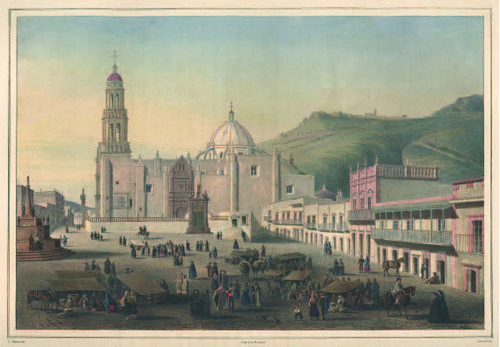
Zacatecas in c. 1836
In November 1810 the first insurgent coinage of the War for Independence was struck in Zacatecas. In fact, it was the first provisional/necessity issue struck during the War by any authority. The other 1810 issue, at Sombrerete, was punched by separately counterstamping each side of a planchet rather than striking a coin with dies. This first coinage has previously been misattributed as a Royalist Provisional issue. As the first Independent coinage, it is historically important and largely misunderstood due to these prior attributions. Research has uncovered a number of previously unpublished contemporary documents in the Mexican National archives which, taken together with previously available sources and a detailed timeline of Insurgent movements in Zacatecas, conclusively show that the first LVO issues of Zacatecas are Insurgent issues and were clearly known as such in contemporary times. Following is the first detailed presentation of these events and documents. You will hear the testimony of Hidalgo himself as well as his rebel lieutenant José Jiménez confess to minting this coinage. On the Royalist side, General Calleja, Coahuila’s Governor Bustamante, the director of the Mexico City Mint and Zacatecas’s Intendant Yrrisorri will all identify and condemn the first LVO coinage as an illegal Insurgent coinage and even the traveler Enrique de Olavarria will muse about it. This article covers the first coinage of Zacatecas issued in 1810 and 1811 which prominently features the city’s LVO motto on the obverse.
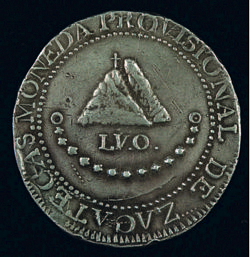
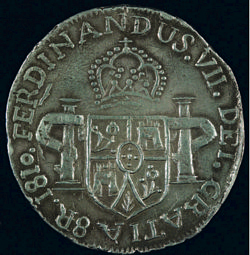
1810 Insurgent/Local arms LVO 8 Reales
Insurgent General Rafael Iriarte entered Zacatecas on 30 October 1810Historical sources vary widely on this date with citations as early as 20 October and as late as 2 November. This is often the case with exact dates of historical events during the War for Independence and the variation is rarely material to numismatic subject matter. For readability I will generally accept Bancroft’s dates as he attempted to consolidate the early sources and will not mention the variability further. just six weeks after the uprising at Dolores began. The revolutionary Insurgent General and his force of several thousand Indians traveled from Aguascalientes which he had sacked two weeks priorAs with dates, the rank of individuals varies broadly by source and of course, could change during the course of the war. Similar variation occurs with the size of their forces. As with dates, I generally default to Bancroft.. Hidalgo had directed him to secure the provincial capital with its wealth and the richest silver mines in Mexico. He entered Zacatecas unopposed. Hearing of the Insurgent advance, local officials including Intendant (Governor) Francisco Rendón had abandoned the city he considered indefensible on 8 October. Most Europeans including the city’s merchants fled as well, taking their valuables and most of the city’s money supply with them including a quarter of a million pesos in coined silver and three million pesos in silver barsAlaman, Historia de México, tomo II, p.18. This left Zacatecas and its large mining operation without money to pay the minersArchivo General de la Nacion. abbreviated AGN; Vol. 415 exp 8 of AGN, Casa de Moneda..
In the vacuum left by the departed Royalists, an all criollo (Mexican born Spaniards) Ayuntamiento or Council emerged and designated Miguel Rivera, the Count of Santiago de Laguna, as Intendant of the province. Simultaneously, the local populace revolted in support of the revolution. Laguna’s influence is the only thing that prevented a plunder of the town. A liberal, the Conde de Laguna tried to conciliate each sides’ interest and prevent violence. On 15 October the deputies of the Real de Mines requested authorization to open the mines and a provisional mint.5 Without Royal consultation the miners obtained this authorization from Laguna and the Ayuntamiento on 26 October, just a few days before the Insurgent forces arrived. As Rafael Iriarte entered Zacatecas on 30 October, Laguna sent Dr. José María Cos to negotiate and accommodations were quickly reached. Dr. Cos will play a very significant role in future Insurgent leadership and his connection to the Count would further Laguna’s reputation as a liberal sympathizer by Royal officials.
 On 12 November, nearly two weeks after Iriarte took control of the City and its mines, the local silversmith Manuel Ramos was placed in charge of the minting operation. Ramos engraved the first LVO dies himselfAGN, CdM, vol.415, 207-208v. The origin of the design is unknown but it is unusual in several regards. The obverse and reverse legends begin at 9:00 and in the Royal shield the lions are replaced by pomegranates and the bottom pomegranate with the maguey (agave plant). The fleur-de-lis is replaced by five crosses. The obverse displays the arms of Zacatecas with the motto L.V.O. (Labor Vincit Omnia / Work Conquers All). Atop is the Cerro de la Bufa (Bufa hill) with cross in the forefront and El Grillo hill behind with garland below. Zacatecas lies between these two hills. This first LVO design is referred to as the “Local Arms” type in all previous references. We will refer to it as the Insurgent/Local arms LVO.
On 12 November, nearly two weeks after Iriarte took control of the City and its mines, the local silversmith Manuel Ramos was placed in charge of the minting operation. Ramos engraved the first LVO dies himselfAGN, CdM, vol.415, 207-208v. The origin of the design is unknown but it is unusual in several regards. The obverse and reverse legends begin at 9:00 and in the Royal shield the lions are replaced by pomegranates and the bottom pomegranate with the maguey (agave plant). The fleur-de-lis is replaced by five crosses. The obverse displays the arms of Zacatecas with the motto L.V.O. (Labor Vincit Omnia / Work Conquers All). Atop is the Cerro de la Bufa (Bufa hill) with cross in the forefront and El Grillo hill behind with garland below. Zacatecas lies between these two hills. This first LVO design is referred to as the “Local Arms” type in all previous references. We will refer to it as the Insurgent/Local arms LVO.
The reverse proclaims “FERDINANDUS VII DEI GRATIA” which has previously caused this to be mistakenly attributed as a Royalist issue in a way it should not. Recall that Ferdinand VII was imprisoned by the French and Joseph Bonaparte occupied the Spanish throne. Many mainland Spanish bureaucrats, nobleman and clergy accepted this situation but not the New World inhabitants. They viewed the mainland sympathizers as French puppets. According to Spanish law, in the absence of the King, sovereignty rested with the people to hold in trust until legitimate authority was restored. The Insurgent leadership professed loyalty to their imprisoned King claiming to hold sovereignty until his return. The revolutionaries marched from Dolores to Guanajuato under Ferdinand’s banner. The entire coinage of the Independent Supreme Junta government from 1811 to 1814 would carry the proclamation of Ferdinand, as would the Insurgent issues at Zongolica. It was only later in the war that Morelos would separate himself from other Insurgent leaders by disavowing loyalty to the king.
The first Insurgent/Local arms LVO coinage began production on 26 November 1810 and continued thru 6 February 1811 according to a report on the coinage written on 8 January 1814 to Viceroy Calleja by Santiago de Yrrisorri, Intendant of Zacatecas at that time. That time line places the Insurgent/Local arms LVO squarely under Iriarte’ s Insurgent forces. Yrrisorri’s report provides a detailed summary to Calleja of both the Insurgent and Royalist provisional issues of three years before. He states that 171,349 pesos were coined of the Insurgent/Local arms LVO (all denominations) and 866,934 pesos of the Royalist/Royal arms LVO coinage which is described below. Given this specificity, we can assume he was relying on written ledgers that must have been available in 1814. These mintage figures indicate that the combined totals of the 1810 and 1811 Insurgent/Local arms issues are five times rarer than the 1811 Royalist/Royal arms issue, a ratio that experience confirms. They are struck in high fineness silver, with past authors noting a coinage of near pure silver due to the difficulty of assaying/refining the silver in the early operations of the provisional mint.
Iriarte and the Insurgents would hold Zacatecas for three and a half months, from 30 October 1810 until being forced out on 17 February 1811 by Royalist Capitan Ochoa. Upon retaking the city, Capitan Ochoa quickly began coinage with new dies dated 1811 containing a Royalist redesign. Changes to the Insurgent/Local arms design include returning the lions, pomegranate and fleur-de-lis to the arms and rotating the legends to begin at 12:00 as typical for Spanish coinage. Capitan Ochoa probably resorted to modifying the Insurgent/Local arms LVO design as an expedient option to waiting for the creation and approval of a new Royalist design. The silversmith Manuel Ramos continued to serve as mint master following the Royalist take over so it is likely that he engraved these changes Manuel Ramos would continue as mint master until 1817 when he was relieved of duty due to the poor quality of the Zacatecas coinage..

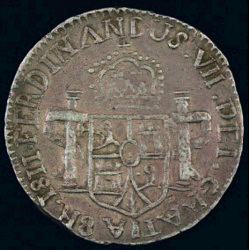
1811 Insurgent/Local arms
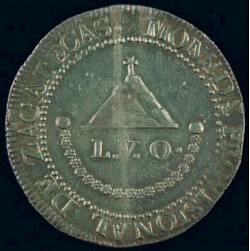
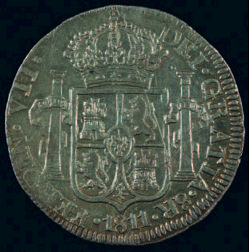
1811 Royalist/Royal arms
Ochoa did not leave a permanent garrison in the City and the Insurgent General Rayón briefly reoccupied Zacatecas on 15 April 1811 and held it until 1 May. During this short period, General Rayón opened the rich mine of Quebradilla and off ered a third of the silver mined to anyone willing to work. This attracted thousands of miners and produced large quantities of silver which was coined Bancroft XII p.309 Intendant’s Yrrisorri report is silent on this two-week period. It is likely Rayón’s forces utilized the Royalist/Royal arms LVO dies they would have found there rather than create new Insurgent dies but this is only speculation lacking a contemporary confirmation. Rayón abandoned the city on 1 May 1811 ahead of the advancing Royalist General Calleja who entered without opposition on 3 May 1811. Rayón’s two week stay is numismatically significant as it will lead subsequent researchers astray as you will soon see.
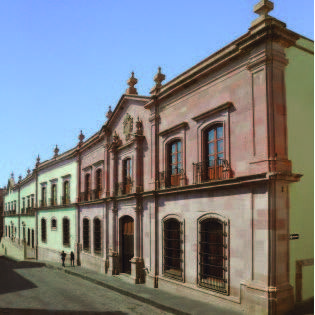
Exterior of Zacatecas mint (1802 - 1905)
It should be clear from the above sequence that the Insurgent/Local arms LVO could only be approved and struck by Insurgent forces since it occurred entirely under their occupation. Their purpose in taking Zacatecas was to capture its wealth and it is inconceivable that they did not control the minting operation. But the evidence goes much further, starting with the testimony of revolutionary leader Miguel Hidalgo himself. Hidalgo was captured with Insurgent leaders José Jiménez, Ignacio Allende, Juan Aldama and over 900 of their men at Acatita de Baján (Wells of Baján) in March 1811.
Following his capture, Hidalgo was placed on trial and his sworn testimony survives. A summary of relevant portions of his testimony are as follows:Pradeau and others have published English translations which vary slightly but not on any significant facts. This summary comes from Pradeau’s translation. While not a direct translation, all relevant facts and events are unchanged.
Hidalgo was asked if in order to further the rebellion he had raised armies, attacked those of the King, coined monies, made guns, arms and ammunitions and had appointed generals and other officers.
Hidalgo replied that he had raised forces with which he had attacked those of the King; that he had coined money in Zacatecas and would have done so in Guanajuato if the establishment had been finished, which factory also produced cannons, arms and ammunition, and that he had appointed generals and other officers.
Insurgent leader José Jiménez, whom we will meet at Real de Catorce, was captured with Miguel Hidalgo and was also placed on trial. A summary of the relevant portions of his testimony is as follows:
Jiménez was asked if he understood the reason for his detention, knew who captured him and if he knew the roles the other prisoners played in the insurgency (Miguel Hidalgo, Ignacio Allende and Juan Aldama).
Jiménez replied that he was aware of the cause of his imprisonment and the roles the others had played in the insurgency. He was aware that he was apprehended by Captain Don Ignacio de Elizondo commanding a garrison from the town of Coahuila.
Jiménez was then asked if it was true that he had gathered militias, fabricated weapons, issued coinage in this province and neighboring areas, had imprisoned and supplanted the legitimate authorities, had issued proclamations and edicts and had proposed an alliance with the United States.
Jiménez answered that it is true that he had gathered his garrison in San Luis Potosí and added troops in El Venado, Charcas, Matehuala and Catorce. He acknowledged that he had fabricated weapons such as spears and cannons in Matehuala and Catorce and that he issued coinage in silver of full fineness and intrinsic value in Real de Catorce. He said that it is true that he imprisoned the legitimate authorities and replaced them with his appointed men, and that he has indeed issued proclamations and edicts. He said that all these actions resulted from his need to preserve his safety by embracing the insurrection despite being well aware of its consequences. Regarding the minting of coinage, he said that he had only minted coinage following the example of Zacatecas (Insurgent LVO issue) to provide a circulating media, but always being careful of not harming the King’s interests by giving it proper weight and full intrinsic value.
Coinage was the King’s prerogative and off ences were punishable by hanging so both Hidalgo and Jiménez had every reason to downplay or deny their culpability. Yet in sworn testimony, Hidalgo admits the Zacatecas coinage and Jiménez confirms it! The preeminent numismatic author Dr. Alberto Pradeau seems to have been unaware of this testimony and of Iriarte’ early occupation of Zacatecas, and instead only identifies Rayón’s later coinage with the Royal diesA. F. Pradeau, Numismatic History of Mexico, p.92. Author Miguel L. Muñoz was familiar with Hidalgo’s testimony and yet in his 1968 publication The First Mint of the Mexican Insurgents surprisingly determined that all the LVO types were Royalist dies which were then used by Rayón in May 1811 to restrike Royalist type coinsMuñoz, The First Mint of the Mexican Insurgents, Sociedad Numismatica de Mexico, 1968, p. 22, available in the USMexNA online library.. This is baffling since Hidalgo was captured two months before Rayón reentered Zacatecas on 15 May. How could Hidalgo confess to a coinage struck after his capture? Muñoz goes on to incorrectly credit Morelos’s August 1811 coinage as the first Insurgent issue. Muñoz was not aware of all the documents that follow but nonetheless, what a missed opportunity!
Because this issue has been misattributed for the past 80+ years and to persuade any remaining skeptics I will continue to beat this old horse. Let us look at how contemporaries viewed the Local/Insurgent arms LVO issues during the war.
| Cast of Characters | ||
| Insurgents | Zacatecas Officials | Royalists |
| Father Miguel Hidalgo | Intendent Count Santiago de Laguna | General Felix Calleja (Viceroy 4 March 1813) |
| General Rafael Iriarte | Dr. José María Cos | Capitan Ochoa |
| Mint Master Manuel Ramos | ||
As previously mentioned, Royalist General Calleja retook Zacatecas on 3 May 1811. This time, the Royalists would fortify the city and leave a trained militia. Zacatecas would never be seriously threatened again! Upon entering the city, Calleja encountered circulating coinage of both the Local/Insurgent and Royalist/Royal arms LVOs and issued an edict approving use of the Royalist design and forbidding use of the Insurgent coinage. Calleja’s edict was published in Gaceta del Gobierno de México on 14 May 1811.
The relevant portions of the edict are summarized as follows:
In order not to hinder payments and trades in commerce, I hereby declare as current and legal tender the provisional coinage minted in Zacatecas by the legitimate authorities which were minted due to the lack of circulating media and have a greater intrinsic value than the one with the bust of the King. However, this authorization applies to the above mentioned provisional coinage, and not the one issued by the insurgents. The coinage of the insurgents will have to be recalled.
Calleja continued minting the Royalist/Royal arms LVO coinage thru August based on Yrrisorri’s report. By late August, a provisional coinage of the proper armored bust design had been created. On 5 September the Zacatecas Provisional armored bust issue of 1811-12 began production. The die and coinage quality were terrible, possibly indicating that any skilled workers left with Rayón’s retreating forces. What they lacked in quality they made up in quantity. Yrrisorri reports a staggering 4,775,138 pesos were minted of the bust type thru 27 March 1813. Fineness is reported as 10 dineros (0.833) far below the prior LVO standard.
Interestingly, Royal authorities diff ered on how to treat the Insurgent LVO coinage during these turbulent times. On 11 May, just three days before General Calleja entered Zacatecas, Antonio Cordero y Bustamante, the Governor of Coahuila declared the Insurgent coinage valid in his Province issuing a proclamation summarized as follows:
The crimes of the insurrection have obstructed and harmed all commercial and mining activities. In order to reestablish order and for the benefit of the people, the coins minted by the insurgents in Zacatecas, Fresnillo and Catorce are to be accepted as legal tender in the province under my authority. These coins are to be accepted in addition to the coins of independent American type, and those minted by legitimate authorities in Sombrerete and Durango, with the understanding that when the circumstances permit, the coins of the insurgents will be recalled on account of the King by paying the full face value to their owners
Fresnillo remains a mystery . Fresnillo is located about 60km (37 miles) NW of Zacatecas and was at the edge of Insurgent control in late 1810. Fresnillo contained one of Mexico’s richest silver mines, the Mina Proaño. It was worked constantly from the late 17th century until 1757 when flooding due to its increasing depth made it uneconomical. The mine is reported to have been abandoned ever since but conceivably the Insurgents found a way to extract silver in the first months of the revolution? No coinage with legends identifiable as Fresnillo is known today. Perhaps the Insurgents in Fresnillo cast Insurgent/Local arms LVO coinage which is known but extremely rare. An intriguing alternative is a coinage yet to be discovered! Now, we return to Zacatecas.
It was not just the Royal authorities who understood that the Insurgents struck the first coinage in Zacatecas. In Enrique de Olavarria y Ferrari’s “Memorias de un Criollo: el 30 de Julio, 1811”, the traveler recounts a conversation with a local resident:
The resident stated that General Calleja has issued instructions allowing the circulation of the provisional coinage issued in Zacatecas by order of the legitimate authorities. When asked why, the resident replied it was because of the complete lack of circulating media and the higher intrinsic value of the provisional coinage compared to the regular one minted in Mexico City.
Olavarria then asked if the coinage of the Insurgents was also allowed to circulate. The resident replied that it will be recalled and melted to continue the minting of the Royalist provisional coinage.
On 23 December 1811 Michoacán Intendent Manuel Merino, issued a proclamation in ValladolidArchivo Histórico Nacional de Madrid, siglo XIX, caja 56, exp. 20, año de 1812 citing Calleja’s prior edict forbidding the circulation of Insurgent coinage and reinforcing its applicability in Michoacán. The relevant section reads as follows:
Everyone is warned that the circulation of the coinage minted in Zacatecas by the insurgents, which is well known and can be distinguished by the fact that it bears a kind of nopal or branch instead of lions in the Royal Coat of Arms – is hereby prohibited.
On 16 June 1812 Michoacán Intendent Merino issued a new edict prohibiting the circulation of all Provisional coinage including Royalist issues due to the confusing mixture of Insurgent, Royalist and counterfeits then in circulation which is summarized as follows:
The insurgents have minted and cast, in different locales, coins in imitation, and counterfeits of the Royalist provisional coinage of Zacatecas which are very difficult to distinguish. Many of the local clothing and food stores and other individuals are refusing to accept the coins for their full face value of one peso, as they cannot distinguish between the ones legally minted in Zacatecas and those that have been counterfeited by the Insurgents, I considered it necessary to either allow the circulation of all of these coins or to forbid the circulation of any coins that have not been minted in the Royal Mint of Mexico.
Having profoundly considered the above matter, I hereby decree:
First, that the use, acceptance and circulation of any kind and type of coinage that is not the one minted at the Royal Mint of Mexico is hereby absolutely forbidden due to the difficulty in distinguishing and differentiating the one that was provisionally minted by Royalist authorities in Zacatecas from the one that has been cast and also struck in imitation by the insurgents in different locales. The differences in these various coins lie in their size, thickness and darkish color of its silver, proving that these counterfeit or illegitimate coins do not possess the corresponding and correct fineness or weight, and that both these coins and the provisional ones struck by our Government are subject to having their weight reduced by clipping them, since they do not have an edge design.
Intendent Merino confirms that the Insurgents cast as well as struck LVO coinage. He also blames them for at least some, if not most, of the LVO counterfeits that circulated widely during this period.
In an authoritative and previously unpublished report by the Mexico City mint director to General Calleja dated 22 June 1812 the director states:
The matter which I consider most important for the reestablishment of the general order and commercial activities in all the kingdom is the recall and complete eradication of those monetary pieces referred to as Royalist and Insurgent Moneda Provisional. The manufacture of these tokens has taken place in the Real de Minas of Zacatecas, Real de Catorce, Sombrerete, Durango and other locales and this bad example has been in turn imitated by the Insurgents.
This arbitrary measure was initially adopted of necessity in the city of Zacatecas under the authority of the Insurgents headed by their caudillo Conde de Santiago de la Laguna. Those tokens, usually referred to as Moneda Provisional de Zacatecas, were given the arbitrary value of one Peso and initially contained an ounce of silver of 12 dineros fineness, and were worth intrinsically more than eight reales in melt value. However, they depicted the signs of the insurrection by substituting the lions with roses in the shield of the obverse and the pomegranate with a maguey in the Royal coat of arms.
After the troops of the King entered Zacatecas, the minting operations of the tokens continued with the only diff erence that the coat of arms was in conformity with the Spanish blazon. However, although their weight of one ounce remained unchanged, their fineness was reduced to 11 dineros or a little less, meaning that those tokens could barely be worth eight reales.
And lately, another series of tokens has begun to be manufactured attempting to improve the previous two, which is in fact the worst of all three series because although they intend to depict the bust of our loved King Don Fernando VII on the obverse by means of a horrible rendition of it, and they bear the Royal coat of arms on the reverse, their fineness is no greater than 10 dineros meaning that their intrinsic value is far less than the purported value of 8 reales which is indicated in their circular legend.
A far worse activity has resulted from the existence of those three series of tokens named Moneda Provisional de Zacatecas, which is the counterfeiting of all of them. The counterfeits have reduced their fineness and weight to scarcely believable levels, since none of those counterfeit tokens has a fineness greater than nine dineros. Since each of those types are found circulating mixed alongside one another it is very difficult to establish their proper value without melting them and then precisely establishing their true weight and fineness.
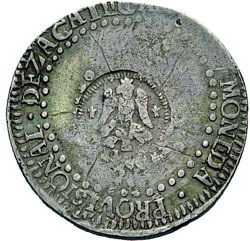

Contemporary Counterfeit 1811 LVO with Norte MNL countersyamo, 24.4 grams
Plate coin in Dasí, Pradeau and Krause
This detailed narrative from the Mint’s director firmly establishes the revolutionary nature of the first Insurgent/Local arms LVO issue. It is also clear that he despises the Royal provisional issues as much as the Insurgent coinage itself! I consider his statement that roses replaced the lions a misinterpretation since on the best struck issues they appear to be pomegranates. He also reinforces Michoacán Intendent Merino’s description of the extensive counterfeiting that is well known to us today from the specimens extant.
To conclude, the Insurgent/Local arms LVO is the first coinage of the Insurgents and in fact, the first struck provisional/necessity issue of any authority. While the concept for a mint was initiated by local miners without Royal consultation, the coinage design and production were completed solely under Insurgent control and was stopped as soon as the Insurgents were expelled from Zacatecas. This fact was confessed by the Insurgent leadership and clearly understood by Royalists and residents of the era. Zacatecas is the First Mint of the Insurgents!
